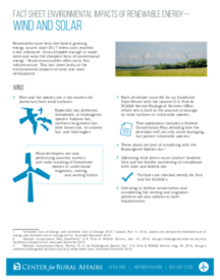Policy
Renewables have been the fastest growing energy source since 2017 when costs reached a key milestone. Costs dropped enough to make wind and solar the cheapest form of conventional energy. Rural communities often carry this infrastructure. This fact sheet looks at the environmental impacts of wind and solar development.
Wind
- Bird and bat species are a top concern for protection from wind turbines.
- Especially key protected, threatened, or endangered species: Indiana bat, northern long-eared bat, little brown bat, tri-colored bat, and bald eagles.
- Each developer must file for an Incidental Take Permit with the nearest U.S. Fish & Wildlife Service Ecological Services Office, which sets a limit to the amount of damage by wind turbines to vulnerable species.
- That application includes a Habitat Conservation Plan detailing how the developer will not only avoid damaging, but protect vulnerable species.
- These plans are part of complying with the Endangered Species Act.
- Operating wind farms must conduct baseline bird and bat fatality monitoring in compliance with state and federal law.
- Turbines are checked weekly for bird and bat fatalities.
- Investing in habitat conservation and considering the nesting and migration patterns are also options to meet requirements.
- Wind developers are now performing acoustic surveys and radio tracking of threatened species to understand migration, mating, and nesting habits.
Solar
- Land used for utility scale solar projects can cause habitat loss.
- Pollinator-friendly solar sites can combine habitat for pollinators with solar arrays, and has been supported through state policy in Maryland, Minnesota, New York, and Illinois.
- Three states—Connecticut, North Carolina, and Washington—have passed policies restricting siting solar projects on agricultural land through either state legislation or county ordinances.
- As an alternative, low-impact solar and co-location of solar and agriculture is a growing area of research with three categories of design:
- Solar-centric
- Vegetation-centric
- Co-location
- As an alternative, low-impact solar and co-location of solar and agriculture is a growing area of research with three categories of design:
- Solar developers have found that combining solar generation with pollinator habitat or grazing land can reduce operations and maintenance costs.


